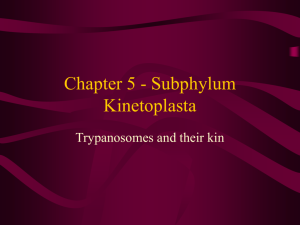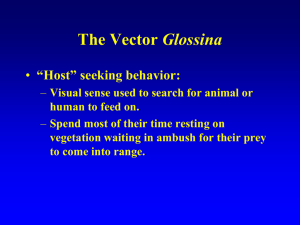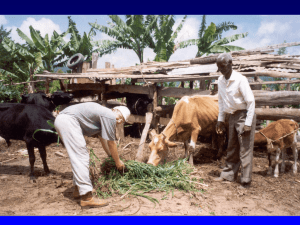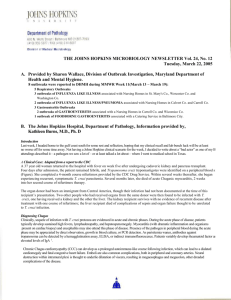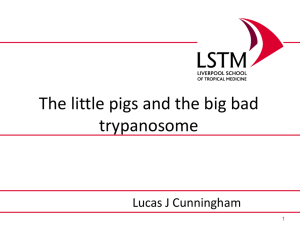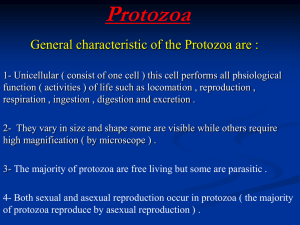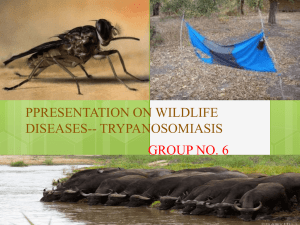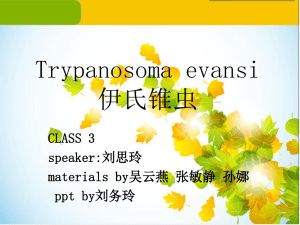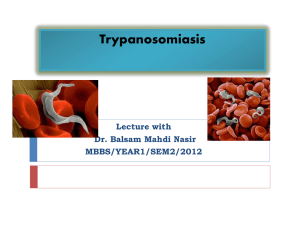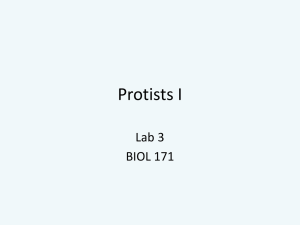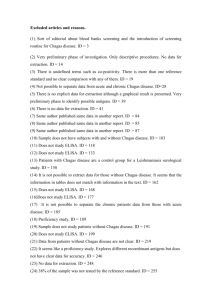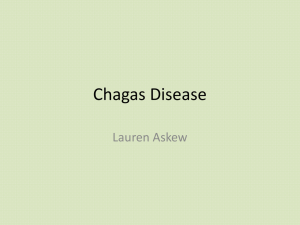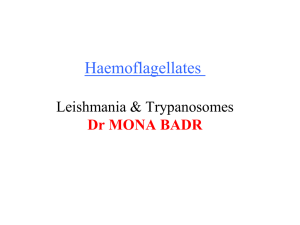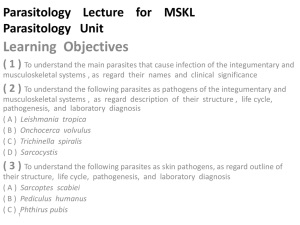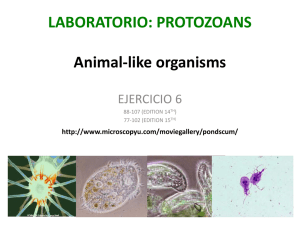Document
advertisement
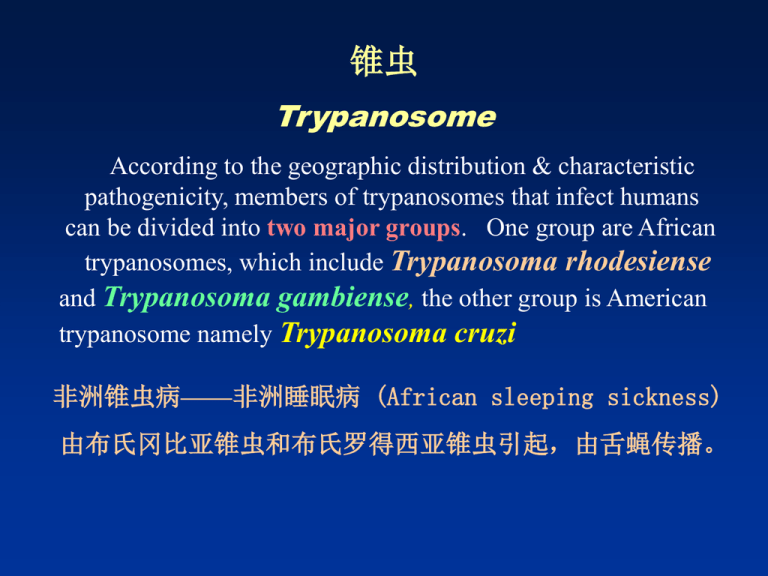
锥虫 Trypanosome According to the geographic distribution & characteristic pathogenicity, members of trypanosomes that infect humans can be divided into two major groups. One group are African trypanosomes, which include Trypanosoma rhodesiense and Trypanosoma gambiense, the other group is American trypanosome namely Trypanosoma cruzi 非洲锥虫病——非洲睡眠病 (African sleeping sickness) 由布氏冈比亚锥虫和布氏罗得西亚锥虫引起,由舌蝇传播。 Morphology & life cycle Tow distinct forms------the trypomastigote------the shape of the letters C or U in stained blood films, in the bloodstream, the trypomastigotes exhibit three forms (1) slender form—long, an undulating member, a free flagellum (2) stumpy form—short, lacking flagellum(3) a form intermediate between both ------the epimastigote----with a large nucleus, a kinetoplast, an undulating member, a free flagellum 舌蝇 粗短型锥鞭毛体 舌蝇 上鞭毛体 循环后期锥鞭毛体 中间型鞭毛体 细长型鞭毛体 Human beings become infected with Trypanosoma rhodesiense or T.gambiense follwing the infection of metacyclic trypomastigotes by the tsetse fly during the blood meal Once introduced into the bloodstream, trypomastigotes spread & multiply rapidly, migrate to the cerebrospinal fluid Tsetse fly get infected when it ingested stumpy trypomastigotes during its blood meal The stumpy trypomastigotes elongate, multiply, converting into epimastigote, then transform into metacyclic trypomastigotes, which are infective stage for human beings Pathogenicity Early stage (初发反应期): inflammatory reaction called trypanoosomal chancer occurs at the site of the bite—reddening in the skin, a swelling 1—5 cm in diameter, enlargement of adjacent lymph nodes Hemolymphatic stage (血淋巴期): the blood & lymph are invaded, headache, irregular fever develop, enlargement of lymph nodes —in the neck & supraclavicular area Winterbottom’s sign Central nervous system stage (脑膜脑炎期): final stage of disease mental retardation, tremors, meningoencephalitis the patient slips into coma and death Epidemiology T. gambiense is found in tropical West Africa & Central Africa T. rhodesiense is found in East & Central Africa 主要由舌蝇传播 移植、输血、注射事故也可传播 Blood transfusion, transplant are additional routes of transmission The antelope (羚羊) may serve as reservoir host 保虫宿主羚羊 Diagnosis Multistep procedure: clinical assessment— examination of blood smears —bone marrow, or CSF for trypomastigotes antibody detection—IFA.ELISA PCR Treatment Suramin 早期疗效100% Eflornithine(依弗鸟氨酸)早晚期会更有效 Suramin is effective against African sleeping sickness when treatment is initiated early in the course of the disease, Eflornithine will be more effective one Trypanosoma cruzi 由 Trypanosoma cruzi引起美洲锥虫病 — Chagas’ disease, Trypanosoma cruzi is responsible for Chagas’disease 由锥蝽 (reduviid bug vector)传播。 Morphology & life cycle amastigote: a nucleus, a kinetoplast, a blepharoplast, an axoneme trypomastigote: similar to that of African trypanosomes T. cruzi is most frequently transferred to a human host when a reduviid bug vector (锥蝽)defecates infective metacyclic trypomastigotes near the site of its blood meal After entry into host, trypomastigotes invade surrounding cell & transform into amastigotes, which are multiply, destroy the host cells, convert back into trypomastigotes The resulting trypomastigotes migrate into the blood, and penetrate additional cells in the body, transform back into amastigotes, the replication & destruction cycle repeat------heart muscle, liver & brain will become infected The trypomastigotes are transmitted back to the reduviid bug via a blood meal 锥蝽 吸血 锥鞭毛体 无鞭毛体 上鞭毛体 球鞭毛体 上鞭毛体 无鞭毛体 循环后期锥鞭毛体 锥蝽 粪便污染 The matacyclic trypomastigotes are then passed with the feces when the bug defecates near the site of its next blood meal, the cycle begins again 夜間吸血 糞便中虫体经傷口侵入 先天感染 輸血 Pathogenicity the parasite invade macrophage of the subcutaneous tissue at the site of infection, causing a local, edematous swelling called a chagoma, kiss bugs ( about 1-3 weeks after infection, fever, headaches, malaise, and prostration may develop) 急性期Chagoma、kiss bugs伴发热、头痛等,也可肝脾肿大 In chronic stage: myocarditis, enlargement of colon and esophagus, hepatosplenomegaly 慢性期 急性后10-20y,心肌炎、巨食道、巨结肠 Epidemiology T.cruci is found in South and Central America, rarely in North America 主要经锥蝽传播 移植、输血、胎盘或被锥蝽粪便污染的 食物也可传播,保虫宿主犰狳。 The highest prevalence of disease is in Brazil Additional routes of T.cruci transmission include blood transfusion, sexual intercourse, transplacental, and entry through the mucous membranes when the bug bite occurs near the eye or month Reservoir host--Armadillo (犰狳) Diagnosis Giemsa-stained blood slides lymph node biopsy giemsa-stained slides culture of blood—NNN medium—amastigotes serologic tests—IFA, ELISA xenodiagnosis PCR Treatment The treatment of choice for infection with T.cruci is nifurtimox
